Asbestos Removal – Everything You Wanted to Know and More
This is the post that I’ve been putting off writing. Why? I was still dealing with the shock of it all. The gist of it is, if you think your home is safe from asbestos, you could be dead wrong! I thought our home was in the asbestos-free time frame, but I was sorely mistaken.
Background: What started as a small leak turned into a massive gut of our kitchen. The disaster restoration team came in and started assessing the damage. What happened next was a downward spiral of issues I pray never happens to you. The polybutylene pipe failure from two weeks ago turned into a full blown mold remediation (luckily it wasn’t black mold.) Shortly after removing the water soaked base cabinets in our kitchen, the project manager discovered old vinyl flooring under our newer vinyl flooring. He told me that they sent a sample to the lab for asbestos testing. I said, “Okay.” And dismissed it knowing that our house couldn’t possibly contain asbestos. The next morning I got a phone call, “The lab results came back and that old flooring tested positive for asbestos.”
What I learned over the next few days about asbestos both scared me and re-assured me. Now that our home is officially asbestos-free and we’ve finally moved back into the house, I’m emotionally ready to share with you what I learned.

Asbestos fibers under a microscope courtesy of Wikipedia Commons
What is asbestos? (source: EPA.gov)
Asbestos is a mineral fiber. It can be positively identified only with a special type of microscope. There are several types of asbestos fibers. In the past, asbestos was added to a variety of products to strengthen them and to provide heat insulation and fire resistance. Asbestos as a building material made sense before it was discovered to cause health problems. It was heat and fire resistant and the glues that contain asbestos work REALLY well. You can’t get glue for vinyl flooring today that sticks as well as the asbestos based glues. Thankfully, asbestos has been banned in the US.
But, here is the crazy thing: Back in the early 1900’s asbestos was suspected to be a health hazard. In 1924, a UK citizen was the first person diagnosed with Asbestosis (progressive fibrosis of the lungs.) In 1931, the term Mesothelioma (a rare form of cancer) was used in medical literature. But, the risks and dangers of asbestos were swept under the rug and hidden until the 1970’s. Finally, in 1989 asbestos in building materials was phased out and eventually banned in 2003. That is almost 80 years after the dangers of asbestos were first discovered! Which means that in the meantime asbestos was used in almost a million residences and buildings. And over 100,000 people have become ill or died from asbestos exposure.
Asbestos is used in (but not limited to) per Wikipedia:
- Roofing and siding materials
- Some roofing and siding shingles are made of asbestos cement
- Insulation of a home built between 1930-1950
- Attic and wall insulation as vermiculite ore
- Textured paint and wall patching
- Artificial ashes and embers used in gas fireplaces
- Old stove-top pads
- Walls and floors around woodburning stoves can have asbestos fiber, millwork or concrete pads
- Vinyl floor tiles and the backing on vinyl sheet flooring
- Vinyl floor adhesives
- Asbestos blanket or tape on hot water and steam pipes in older homes
- Oil and coal furnaces door gasket insulation
The bottom line is that your home could have asbestos products even if it was built in and prior to 2003. The asbestos abatement team told me that just because there was a ban placed on the use of asbestos, there were still products containing it on store shelves. For this reason, you should never assume that your home is asbestos-free. It is much safer to have a professional test for asbestos if you don’t know. Then discover that you were exposed when it is too late.
What to do if you suspect (and even if you don’t suspect) that you have an asbestos product in your home:
First of all, don’t freak out. Call a professional asbestos abatement company and have them do a quick test on the product. They will take a 1″ sample of the material and perform a PLM (Polarized Light Microscopy) test by looking for asbestos fiber structures under a microscope. If it is determined that you have asbestos, you need to determine the risk of the fibers being released into the air. If you have asbestos flooring that is in good condition (not flaking, damaged or will be tampered with) you can lay new flooring over top of the old floor. In the case of our vinyl flooring, one of the previous owners had added new flooring on top of the old. This is acceptable, but it must be disclosed that there is asbestos flooring in the home when you go to sell. It is presumably safe to live in a home that has asbestos products as long as they aren’t at risk of creating air borne fibers.
In our case, the mold remediation team had to remove the water soaked floor and would be damaging the old asbestos vinyl underneath. This could loosen and expose fibers that could be inhaled and potentially lead to health problems.
How Asbestos is Removed?
I was told that we could stay in the house during the abatement, but there was no way I was going to chance having my kids in the house. We decided to move everyone out of the house (complicated by the fact that we were getting headaches from the mold.)
The abatement team arrived and sealed off the room(s) completely. Doorways, ducts and even the windows are sealed with plastic. Big scary asbestos signs are placed on every doorway to deter people from entering.
Two giant HEPA filters are installed outside a window and suck the air out of the room. This creates negative air pressure which prevents air from escaping into the rest of the house.
The asbestos abatement team wears disposable suits (and I was told even disposable underwear.) They wear respirators and gloves.
The floor boards are cut into manageable sections and the edges are taped off to contain the asbestos backing and glue under the vinyl. The sheets are loaded into a truck. All debris is vacuumed and cleaned from the room and disposed of in plastic bags. All the contaminated materials, clothing, etc. are hauled back to the abatement company where they are dumped into a special sealed dumpster for asbestos products.
After the abatement team is done, they must strip down and take a shower (usually a portable shower is brought to the job site.) Only after the shower can they put on their regular clothes.
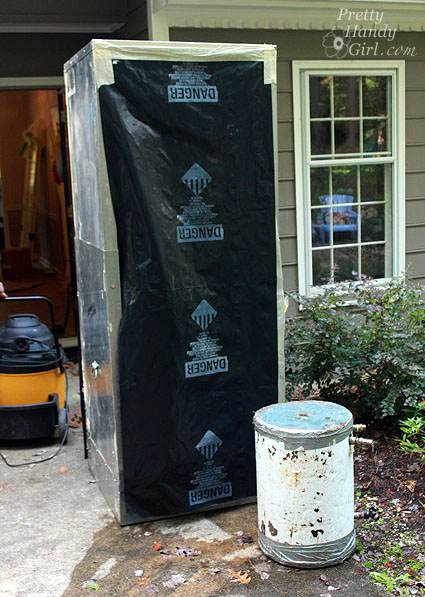 Portable shower for abatement team to use after finishing the job.
Portable shower for abatement team to use after finishing the job.
Air test for Asbestos
After the abatement is complete, an air test must be performed before anyone can enter the room without protective gear. A TEM (Transmission Electron Microscopy) or a PCM (Phase Contrast Microscopy) air sample is analyzed. In our house, the TEM was used which is supposedly more accurate. The technician was a trained professional who put on his own protective gear. He ran a leaf blower around the room to stir up any dust and fibers that may have settled on the floor and in crevices. Then ran a small vacuum pump that sucked air through a filter for 45 minutes.
An acceptable asbestos air test will come back with less than .01 fibers per cc. Luckily our home was clear and we were allowed to move back in. But, now this is our reality:
That’s right, we now have a scooter track in our home. I may miss our kitchen, but the boys don’t seem to mind.
To be continued…
You can read more about our kitchen disaster and renovation in these updates:
- Polybutylene Pipe Leak turns into Moldy Mess
- Planning New Kitchen Layout and more
- Planning Colors and Materials for the New Kitchen
- Let the Demolition Begin
- How to Remove Soffits
- Move Back in the Kitchen Temporarily and Throw a New Year’s Party
- Termite Damage and Kitchen Update
- How and When You Should File for a Permit during a Kitchen Renovation – Your Questions Answered
- Everything You Should Know about Termites and Termite Damage
- Structural Engineer Plans and another Kitchen Update
- How to Survive without a Kitchen During Renovation

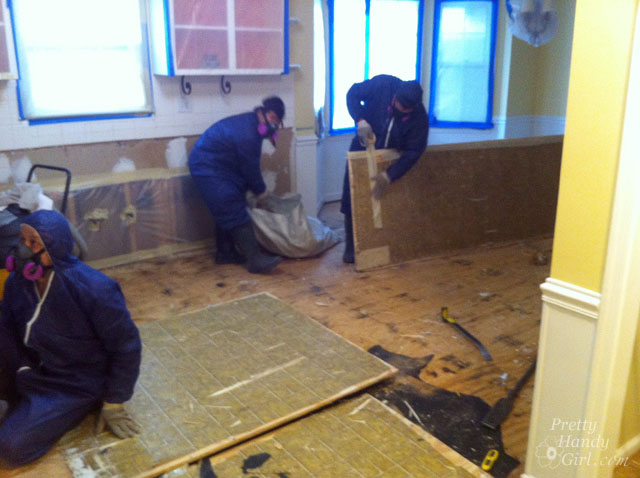
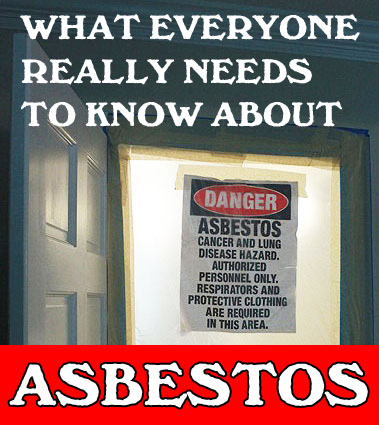
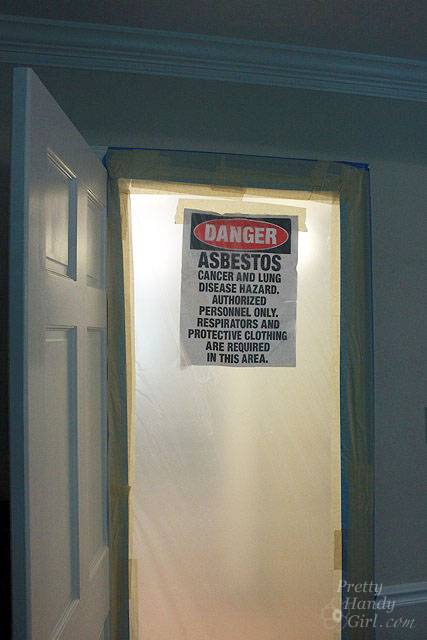
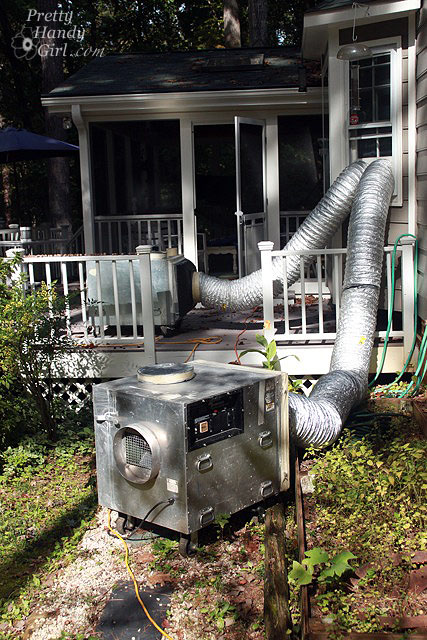
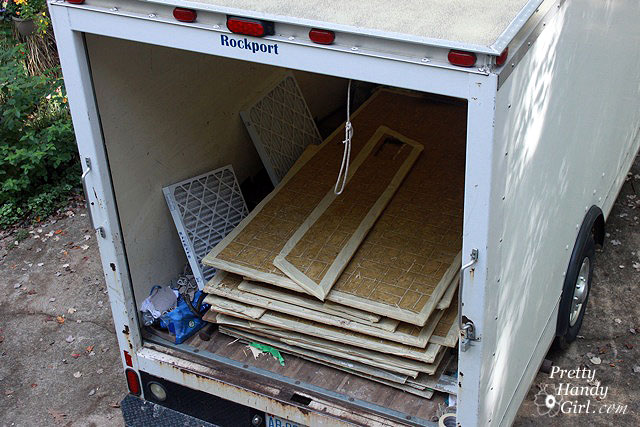
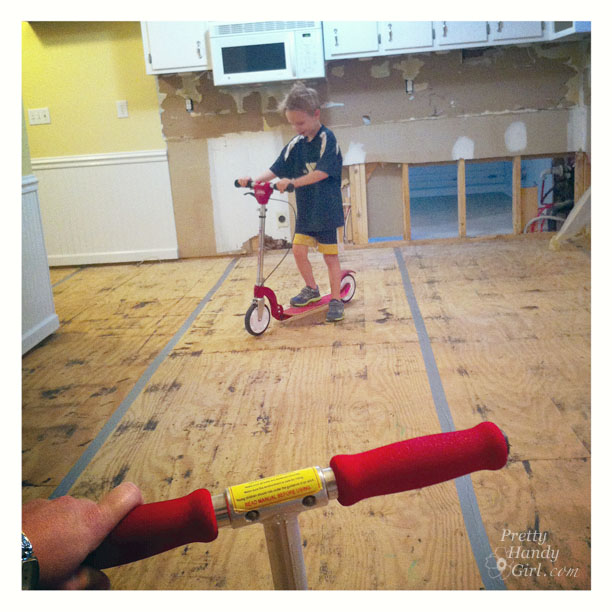



Hey Brittany! After running into you at Haven and our brief talk about asbestos, it’s ever present in my mind, especially as I start on my kids’ bathroom renovation/makeover for my August Upgrade challenge. My house was built in 1973, and I’m so thankful that you brought this to my attention because I just didn’t think about it. I haven’t removed any vinyl flooring in my house (although we have it); I’ve just gone over it with Snap Stone interlocking porcelain tiles, which worked well for my laundry room. I’ll be doing it for my kids’ bathroom, too, where there is vinyl tile. But I’ve got this decorative board stuff that is adhering to the top of my kids shower, and I’m afraid to remove it. It’s sort of like beadboard. I’m going to call someone in to do an inspection just to make sure. I can’t move forward without knowing for sure…. Thanks for the warnings! 🙂
Serena @ Thrift Diving
Thanks for sharing. My husband and I are going through a similiar process following a leaky dishwasher, great to hear what the process is like. we tested positive today, waiting to hear the next steps from the restoration crew!
We are in the process of remodeling our home. We have the vinyl tile and likely linoleum as well. Is the removal of kitchen linoleum with asbestos considered friable vs. non friable? Is negative air enclosure required? Is it common for asbestos to be in plaster walls? Our home was built in 1957. I never thought this would be so stressful!
Thanks!
Esther,
First, I am an abatement professional. I have worked on the removal as well as the testing sides of asbestos work. If you had respiratory issues so early, it is not the asbestos, but probably instead a mold or air duct issue. Asbestos does not affect the respiratory system so quickly, and will not cause pneumonia. Also, the painter has no way of knowing if the popcorn ceiling is asbestos or not; but in his defense – if a contractor doesn’t know, they HAVE to assume it is positive for asbestos (lead paint is the same).
Contact your local housing organization, they may have programs that can assist in the testing/removal of asbestos and lead in your home. – They may even have a program that will not only remove the hazardous materials, but will reinstall new items (doors, walls, windows, etc) for free or at least at a reduced price.
Popcorn ceiling is a friable – Class I work – will need to be removed inside a negative air enclosure.
Floor tile is non-friable – Class II work – if removed with hand tools (putty knives, 5 in 1’s) does not need an enclosure; and removal yourself is quick and easy (you can legally place in bags and put with your normal garbage).
I do not recommend removing linoleum yourself as it tends to tear between layers, thus releasing the asbestos fibers.
Pipe insulation can be spray painted (encapsulating) which will hold the asbestos in a matrix.
Hope all this helps!
Excellent information! Thanks for replying Mark.
Hi Brittany,
Wow, what a story. You provided some useful insights and things most of us would never have even thought of.
We have city-sewer and recently had 2, yeah, 2, backflows into our utility sink in our basement. The first wasn’t too bad, just the sink and a little overflow onto the floor and rugs. We cleaned up, had a drain company snake the sink drain, and moved on. The second, the very next day, was gushing, smelly, chunky discharge all over the floor, running out of the sink, getting to a depth of about 2′ in places before the h2o was shut off. I don’t know why having the h2o on complicated the issue, but shutting it off stopped the gush. I bailed with a trash bucket out the back door into some rocky planted area. The drain company came back and snaked 2x out to the street (about 90 feet of snake, he said), didn’t have any tree roots or feel any breaks, just some “thickness”, which he got thru both times with effort. He suggested contacting the town and having the sewer line flushed to be sure it was clear. Did that the next day; of course, they said they were ok. Contacted the ins. co….luckily we are covered for the loss. However, the clean up company that came in to help said that the flooring under the carpet was most likely asbestos and they couldn’t do more than soak and wash it. They wiped down almost everything, took the destroyed stuff, and working with the ins. co. got an asbestos tester to come. This was all in the last 2 wks. We should have the results in another day or so. We’ve done a complete empty of the room of all belongings so they can come in and remove, or the clean-up comp. can come and do if no asbst.. The tester also said we would be ok to stay, but I’m not feeling too confident. At what point would you suggest leaving? Before they begin, or when they are ready to leave as well? I don’t want to leave the house open for anyone to walk in as we’re close to the city and I’m not that trusting. Thoughts? Any are appreciated! Thanks for all the insights. Wish us luck!
kim
Kim, you are safe as long as the asbestos material (fibers) aren’t disturbed. Once they start ripping up anything that will expose or disturb it, I’d leave the house until you have the clean air test results. Make sure they leave the tarps up if there is asbestos abatement until the air test is passed.
Hi, thank you for posting this. How long did you keep your kids out of the house after the removal? The work has to be done in my toddler’s bathroom across the hall from his bedroom, so I’m a little paranoid about his being here.
Julie, the tarps and everything remained up for 24 hours after the work was done until we got the lab results back that it was asbestos-free. So, it would depend on how quick you can get a tech to take the air test results and how quickly they can get it to through the lab. For extra caution, I kept the kids out of the house while the work was being done. But, they were also set up at my in-laws at that point anyway, so we didn’t have any rush to get back in.
Did your asbestos abatement company make you empty out your ENTIRE KITCHEN of all dishes and food before they would come in and do their work?
Jackie, yes, but our kitchen was also almost completely gutted due to the water leak and mold issues.
Your house seems alot like mine. popcorn ceiling, chair rails all over (which i like) and vinyl flooring under the tile. was your house built in 1970?
Hello. I purchased a home in 2001, withoud doing any inspection. My husband and I started having respiratory problems since then. Today, someone came to paint the home, and said that because I have popcorn ceiling, he wont paint because he is sure we have ASBESTOS> Who do I contact, and if I do, the house might need demolition. Does the homeowners insurance pay for that ? The painter was 100% sure I have mt the home told and asbestos, and that is what is causing recurring pneumonia in my family. We don’t have a lot of money, and if the insurance wont cover the repairs, or demolition, where else am I supposed to go? meanwhile, if I do stay we will die of lung cancer.The house was built in 1932. PLease help. Sick and desperate. Thank you
Esther, I think the first step would be to contact your insurance agent. They will be able to tell you if it is covered or not. If they can’t help you, try contacting your city or state building and planning office. If it’s just the popcorn, remediation by a professional shouldn’t be too difficult and I can’t imagine your house would need to be demolished. Good luck to you and your family.
Hi I admit to being scared to buy an older home due to the risk of asbestos which is a shame because they are usually well built and considerably more affordable is it safe to assume that every house built before the late 1970s or 1980s contains some asbestos somewhere? Sorry to be the one to ask the hard questions but you never say what the age of your home actually is only that you assumed it was too new to have asbestos issues and that you sent it out for testing and it came back as positive for asbestos. What year was your home built? Its hard to believe a home built in the late 80s or early 90s for instance has such a severe problem.I have to ask are you really sure the test result was trustworthy and accurate? Was it done by the same company that stood to gain financially from asbestos removal or had a connection to the company that you hired for the removal ? Did you get a second opinion? Just asking.
Lisa
Lisa, our house was built in 1978. I actually do know now that the testing was correct as we have since found out that previous owners knew about the asbestos and so chose to cover the existing floor rather than risk exposure by ripping it up. I wouldn’t be scared of buying an older home. Just educate yourself and ask for tests when you are considering buying one.
Did you have drywall tested for asbestos?
The contractor that the insurance company sent tested it. Typically you’ll find it in the joint compound, but it can also be in drywall.
I assume that it was negative? I am planning some renovations and sent some vinyl flooring from (I assume) the early 70’s in for testing. If it comes back positive I’ll probably just cover it with 1/4″ plywood and then go with vinyl (fake) ceramic tile instead of what I really want (ceramic). This is due to the fact that I there is particle board under the vinyl, so they won’t put ceramic tile on top of that. Now I am also thinking about the drywall – never occurred to me in the past when doing things that it could be in there – have drilled into it more than once. I hope that it comes back free of it because I want to tear my ugly soffits out! 🙂
Oh I’ve been there. I hope it comes back negative. Be forewarned that, by law, you will have to disclose the presence of asbestos in your home if you cover it up. Plus, your floor height will change, from the rest of the house. It might be worth it to get a quote for abatement.